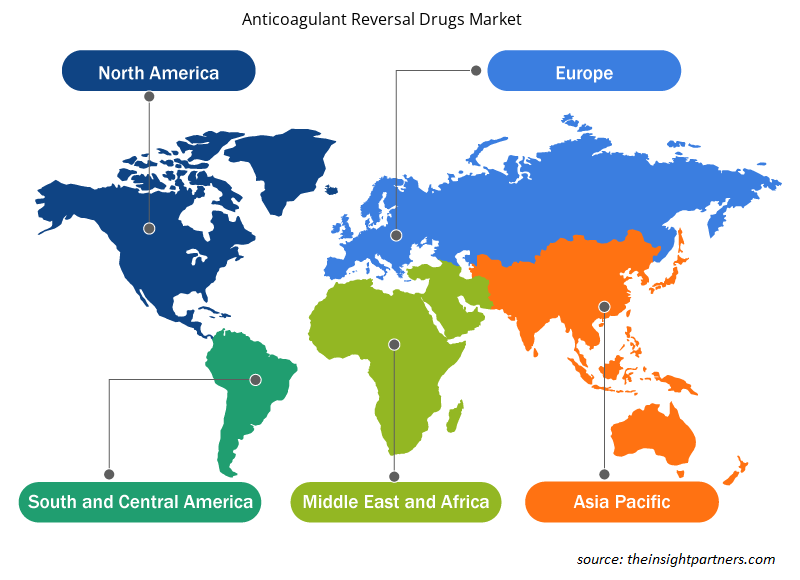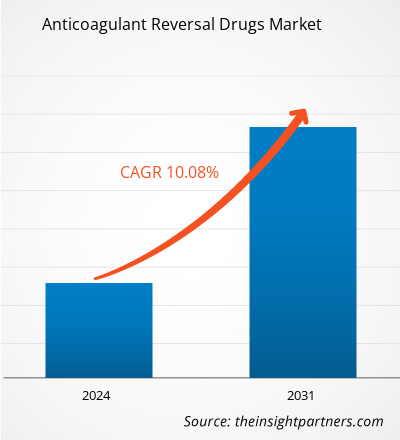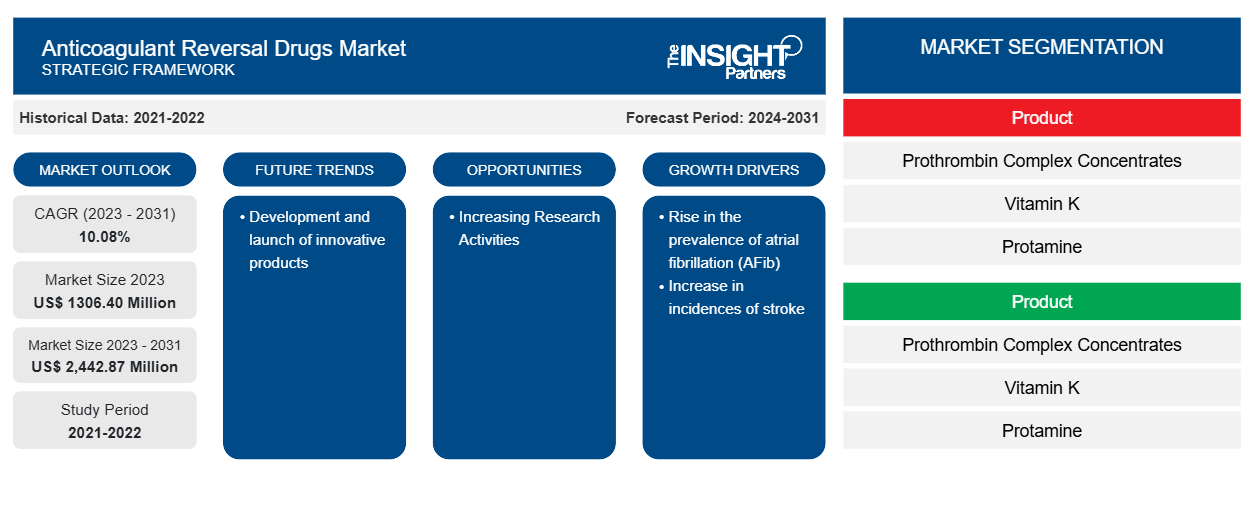Si prevede che la dimensione del mercato dei farmaci anticoagulanti per l'inversione raggiungerà i 2.442,87 milioni di dollari entro il 2031, rispetto ai 1.306,40 milioni di dollari del 2023. Si prevede che il mercato registrerà un CAGR del 10,08% nel 2023-2031. È probabile che lo sviluppo e il lancio di prodotti innovativi rimangano tendenze chiave del mercato dei farmaci anticoagulanti per l'inversione.CAGR of 10.08% in 2023–2031. Development and launch of innovative products are likely to remain key anticoagulant reversal drugs market trends.
Analisi di mercato dei farmaci anticoagulanti
Negli ultimi anni, l'uso di anticoagulanti è aumentato per prevenire e trattare varie condizioni cardiovascolari come embolia polmonare (EP), trombosi venosa profonda (TVP), fibrillazione atriale (FA), trombosi valvolare cardiaca meccanica e sindromi coronariche acute. Tuttavia, l'uso diffuso di questi trattamenti comporta il rischio di emorragie maggiori e minori, che portano a ricoveri ospedalieri e visite al pronto soccorso. Questo rischio può aumentare se ai pazienti viene prescritta una terapia di combinazione costituita da un anticoagulante e un antiaggregante piastrinico o una doppia terapia antiaggregante. Quando usati da soli, warfarin e aspirina presentano il rischio di emorragia più elevato. Pertanto, i farmaci anticoagulanti vengono utilizzati per prevenire le emorragie. Si prevede che l'aumento della prevalenza di fibrillazione atriale (FA) e l'aumento dell'incidenza di ictus favoriranno lo sviluppo di nuovi trattamenti per migliorare la parola.DVT), atrial fibrillation (AF), mechanical heart valve thrombosis, and acute coronary syndromes. However, the widespread use of these treatments carries the risk of major and minor bleeding, leading to hospitalizations and emergency department visits. This risk can increase if patients are prescribed combination therapy consisting of an anticoagulant and antiplatelet or dual antiplatelet therapy. When used alone, warfarin and aspirin have the highest bleeding risk. Thus, anticoagulant reversal drugs are used to prevent bleeding. The rise in the prevalence of atrial fibrillation (AFib) and the increase in incidences of stroke are expected to favor the development of new treatments to improve speech.
Panoramica del mercato dei farmaci anticoagulanti
Come evidenziato dai Centers for Disease Control and Prevention (CDC), ogni anno negli Stati Uniti si verificano più di 454.000 ricoveri ospedalieri correlati alla fibrillazione atriale, con conseguenti circa 158.000 decessi. Inoltre, il rischio di sviluppare la fibrillazione atriale aumenta con l'età e l'ipertensione, che diventa anche più comune con l'avanzare dell'età, è un fattore in circa 1 caso su 5 di fibrillazione atriale. Si prevede che la crescente popolazione geriatrica porterà a un aumento della domanda di farmaci anticoagulanti invertenti nel prossimo decennio.
Personalizza questo report in base alle tue esigenze
Riceverai la personalizzazione gratuita di qualsiasi report, comprese parti di questo report, o analisi a livello nazionale, pacchetto dati Excel, oltre a usufruire di grandi offerte e sconti per start-up e università
- Scopri le principali tendenze di mercato in questo rapporto.Questo campione GRATUITO includerà analisi di dati che spaziano dalle tendenze di mercato alle stime e alle previsioni.
Driver e opportunità di mercato per i farmaci anticoagulanti
Malattie neurodegenerative e disturbi del linguaggio in aumento per favorire il mercato
I farmaci anticoagulanti reversibili sono utilizzati nella gestione dell'ictus emorragico per ridurre il sanguinamento in corso e consentire ai tessuti di riprendersi. C'è stato un aumento della prevalenza di ictus nei paesi a basso e medio reddito. Secondo la Stroke Awareness Foundation, circa 795.000 individui soffrono di ictus ogni anno negli Stati Uniti, il che rappresenta oltre 140.000 decessi ogni anno. Di questo numero, circa il 40% dei decessi correlati all'ictus si verifica nei maschi, mentre il restante 60% si verifica nelle femmine. In un articolo pubblicato da Annals of Palliative Medicine (APM) nel maggio 2021, una combinazione di concentrato di complesso protrombinico a 4 fattori, plasma fresco congelato e vitamina K1 è stata somministrata a un paziente in trattamento con warfarin che soffriva di ictus ischemico acuto (AIS). Il rapporto ha mostrato un miglioramento neurologico e un'inversione riuscita della coagulazione nei pazienti AIS con ipercoagulabilità correlata al warfarin. Pertanto, l'aumento dell'incidenza degli ictus è uno dei principali fattori che determinano la quota di mercato dei farmaci anticoagulanti.APM) in May 2021, a combination of 4-factor prothrombin complex concentrate, fresh frozen plasma, and vitamin K1 was administered in a patient under warfarin treatment who suffered from acute ischemic stroke (AIS). The report showed neurological improvement and successful reversal of coagulation regarding AIS patients with warfarin-related hypercoagulability. Therefore, propelling incidences of stroke are a major driver of anticoagulant reversal drugs market share.
Aumento delle attività di ricerca: un’opportunità nello sviluppo di nuovi farmaci anticoagulanti in grado di invertire l’effetto
Le attività di ricerca in rapido progresso nello sviluppo di farmaci per nuove terapie in tutto il mondo per contrastare la crescente prevalenza di malattie cardiovascolari, come la fibrillazione atriale, stanno guidando la crescita del mercato dei farmaci per l'inversione degli anticoagulanti. C'è sempre bisogno di approcci terapeutici innovativi nel trattamento di varie indicazioni cardiovascolari. Ad esempio, lo studio intitolato "Valutazione di andexanet alfa e concentrato di complesso protrombinico a quattro fattori (4F-PCC) per l'inversione di emorragie intracraniche associate a rivaroxaban e apixaban", pubblicato a luglio 2020 sul Journal of Thrombosis and Haemostasis, è stato condotto presso il Massachusetts General Hospital, per studiare l'efficacia di andexanet alfa nel trattamento delle emorragie intracraniche (ICH). Pertanto, il numero crescente di attività di ricerca sta stimolando le attività di scoperta di farmaci e offrendo opportunità redditizie per la crescita del mercato in tutto il settore.andexanet alfa and four‐factor prothrombin complex concentrate (4F‐PCC) for reversal of rivaroxaban‐ and apixaban‐associated intracranial hemorrhages,’ published in July 2020 in the Journal of Thrombosis and Haemostasis, was conducted in Massachusetts General Hospital, to investigate the efficacy of andexanet alfa in the treatment of intracranial hemorrhages (ICH). Thus, the increasing number of research activities is boosting drug discovery activities and offering lucrative opportunities for market growth across the industry.
Analisi della segmentazione del rapporto di mercato sui farmaci per l'inversione degli anticoagulanti
I segmenti chiave che hanno contribuito alla derivazione dell'analisi di mercato dei farmaci per l'inversione degli effetti anticoagulanti sono il prodotto e il canale di distribuzione.
- In base al prodotto, il mercato dei farmaci anticoagulanti è suddiviso in concentrati di complesso protrombinico, vitamina K, protamina, acido tranexamico, idarucizumab e AndeXXa. Il segmento dei concentrati di complesso protrombinico ha detenuto la quota maggiore del mercato nel 2023.
- In termini di canale di distribuzione, il mercato dei farmaci anticoagulanti per l'inversione è segmentato in farmacie ospedaliere, farmacie al dettaglio e altri. Il segmento delle farmacie ospedaliere ha detenuto la quota maggiore del mercato nel 2023.
Analisi della quota di mercato dei farmaci anticoagulanti per area geografica
L'ambito geografico del rapporto di mercato sui farmaci per l'inversione degli effetti anticoagulanti è suddiviso principalmente in cinque regioni: Nord America, Asia Pacifico, Europa, Medio Oriente e Africa, e Sud e Centro America.
Il Nord America ha dominato il mercato dei farmaci anticoagulanti. In Nord America, gli Stati Uniti sono il mercato più grande per i farmaci anticoagulanti. La crescita di questo mercato è guidata principalmente dalla crescente prevalenza di malattie cardiovascolari come la fibrillazione atriale, dagli sviluppi degli operatori di mercato e dalla presenza di importanti operatori di mercato negli Stati Uniti che accelereranno la crescita di questo mercato in questo paese. Inoltre, è probabile che gli sviluppi strategici degli operatori di mercato negli Stati Uniti favoriscano la crescita del mercato. Ad esempio, a giugno 2023, AstraZeneca ha proceduto con le richieste di autorizzazione regolamentare complete per il suo Andexxa (andexanet alfa) negli Stati Uniti e nell'UE, andando oltre l'attuale approvazione condizionale. Andexxa è un trattamento che può invertire rapidamente gli effetti anticoagulanti degli inibitori orali diretti di FXa. Oltre 15 linee guida nazionali e internazionali in più discipline supportano il suo utilizzo. AstraZeneca ha ora proceduto con le richieste di autorizzazione regolamentare per l'approvazione completa dell'etichetta negli Stati Uniti.
Approfondimenti regionali sul mercato dei farmaci anticoagulanti
Le tendenze regionali e i fattori che influenzano il mercato dei farmaci anticoagulanti per l'inversione durante il periodo di previsione sono stati ampiamente spiegati dagli analisti di Insight Partners. Questa sezione discute anche i segmenti e la geografia del mercato dei farmaci anticoagulanti per l'inversione in Nord America, Europa, Asia Pacifico, Medio Oriente e Africa e America meridionale e centrale.

- Ottieni i dati specifici regionali per il mercato dei farmaci anticoagulanti invertenti
Ambito del rapporto di mercato sui farmaci anticoagulanti
| Attributo del report | Dettagli |
|---|---|
| Dimensioni del mercato nel 2023 | 1306,40 milioni di dollari USA |
| Dimensioni del mercato entro il 2031 | 2.442,87 milioni di dollari USA |
| CAGR globale (2023-2031) | 10,08% |
| Dati storici | 2021-2022 |
| Periodo di previsione | 2024-2031 |
| Segmenti coperti | Per Prodotto
|
| Regioni e Paesi coperti | America del Nord
|
| Leader di mercato e profili aziendali chiave |
|
Densità degli attori del mercato: comprendere il suo impatto sulle dinamiche aziendali
Il mercato dei farmaci anticoagulanti per l'inversione sta crescendo rapidamente, spinto dalla crescente domanda degli utenti finali dovuta a fattori quali l'evoluzione delle preferenze dei consumatori, i progressi tecnologici e una maggiore consapevolezza dei benefici del prodotto. Con l'aumento della domanda, le aziende stanno ampliando le loro offerte, innovando per soddisfare le esigenze dei consumatori e capitalizzando sulle tendenze emergenti, il che alimenta ulteriormente la crescita del mercato.
La densità degli operatori di mercato si riferisce alla distribuzione di aziende o società che operano in un particolare mercato o settore. Indica quanti concorrenti (operatori di mercato) sono presenti in un dato spazio di mercato in relazione alle sue dimensioni o al valore di mercato totale.
Le principali aziende che operano nel mercato dei farmaci anticoagulanti sono:
- Sanofi,
- Johnson & Johnson,
- GlaxoSmithKline,
- Salute Bausch,
- Prodotti farmaceutici Takeda
- Azienda farmaceutica Lexicon, Inc.
Disclaimer : le aziende elencate sopra non sono classificate secondo un ordine particolare.

- Ottieni una panoramica dei principali attori del mercato dei farmaci anticoagulanti
Notizie di mercato e sviluppi recenti sui farmaci anticoagulanti
Il mercato dei farmaci anticoagulanti per l'inversione viene valutato raccogliendo dati qualitativi e quantitativi da ricerche primarie e secondarie, che includono importanti pubblicazioni aziendali, dati di associazioni e database. Di seguito è riportato un elenco degli sviluppi nel mercato dei disturbi del linguaggio e della parola e delle strategie:
- AstraZeneca Pharma India Ltd. ha annunciato di aver ricevuto l'approvazione dalla Central Drugs Standard Control Organisation (CDSCO) in India per importare e commercializzare Andexanet Alfa. Questo trattamento è efficace nel trattamento di emorragie potenzialmente letali o refrattarie che si verificano con l'uso di inibitori del fattore Xa (FXa). (Fonte: AstraZeneca Pharma, comunicato stampa, 2024)
- Octapharma USA ha annunciato l'approvazione di Balfaxar da parte della Food and Drug Administration (FDA) statunitense. Balfaxar è un concentrato di complesso protrombinico a quattro fattori non attivato (4F-PCC) contenente fattori dipendenti dalla vitamina K: fattore II (protrombina), fattore VII, fattore IX e fattore X e proteine antitrombotiche C e S. Può essere utilizzato per invertire urgentemente la carenza di fattori della coagulazione acquisita indotta dalla terapia con antagonisti della vitamina K (VKA) in pazienti adulti che necessitano di un intervento chirurgico urgente o di procedure invasive. Balfaxar aiuta a ripristinare la coagulazione del sangue ripristinando i livelli di fattori della coagulazione carenti a causa della terapia con warfarin. (Fonte: Octapharma USA, Inc, comunicato stampa, 2023)
Copertura e risultati del rapporto di mercato sui farmaci anticoagulanti
Il rapporto "Dimensioni e previsioni del mercato dei farmaci anticoagulanti per l'inversione (2021-2031)" fornisce un'analisi dettagliata del mercato che copre le seguenti aree:
- Dimensioni e previsioni del mercato a livello globale, regionale e nazionale per tutti i segmenti di mercato chiave coperti dall'ambito
- Dinamiche di mercato come fattori trainanti, vincoli e opportunità chiave
- Principali tendenze future
- Analisi dettagliata delle cinque forze PEST/Porter e SWOT
- Analisi di mercato globale e regionale che copre le principali tendenze di mercato, i principali attori, le normative e gli sviluppi recenti del mercato
- Analisi del panorama industriale e della concorrenza che copre la concentrazione del mercato, l'analisi della mappa di calore, i principali attori e gli sviluppi recenti
- Profili aziendali dettagliati
- Analisi storica (2 anni), anno base, previsione (7 anni) con CAGR
- Analisi PEST e SWOT
- Valore/volume delle dimensioni del mercato - Globale, Regionale, Nazionale
- Industria e panorama competitivo
- Set di dati Excel
Report recenti
Rapporti correlati
Testimonianze
Motivo dell'acquisto
- Processo decisionale informato
- Comprensione delle dinamiche di mercato
- Analisi competitiva
- Analisi dei clienti
- Previsioni di mercato
- Mitigazione del rischio
- Pianificazione strategica
- Giustificazione degli investimenti
- Identificazione dei mercati emergenti
- Miglioramento delle strategie di marketing
- Aumento dell'efficienza operativa
- Allineamento alle tendenze normative























 Ottieni un campione gratuito per - Mercato dei farmaci anticoagulanti
Ottieni un campione gratuito per - Mercato dei farmaci anticoagulanti